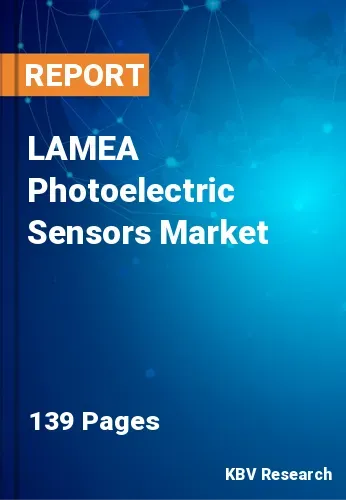The Latin America, Middle East and Africa Photoelectric Sensors Market would witness market growth of 9.0% CAGR during the forecast period (2023-2030). In the year 2026, the LAMEA market's volume is expected to surge to 2,790.7 thousand units, showcasing a growth of 10.9% (2023-2030).
The consistent increase in military spending in both developed and developing nations is expected to stimulate market expansion. In order to ensure the safety of the military and civilian populace, the aerospace and military utilize these sensors for biological agent surveillance and detection. Moreover, introducing intelligent these sensors will stimulate market expansion throughout the projected timeframe. Smart sensors provide many benefits, including diminished operational costs, improved dependability, decreased mass, and decreased times of passivity.
Photoelectric sensors are favoured in non-contact detection applications because they do not require physical contact with objects. This is crucial in industries where contact-based sensors may cause damage or interference with delicate materials or processes. Stringent regulatory standards in various industries, especially automotive and healthcare, drive the need for high-precision and reliable sensing solutions. With their accuracy and reliability, these sensors meet these standards and ensure compliance.
According to the International Trade Administration, the UAE ranks sixth overall in military expenditures as a percentage of GDP (5.6%). The UAE paid $19.8 billion on defence in 2020. Photoelectric sensors, including laser range finders, are used for precise distance measurement. In military applications, laser range finders contribute to accurate targeting and ranging, improving the effectiveness of weapon systems. It plays a crucial role in missile systems in guidance and target tracking. These sensors contribute to the accuracy and efficacy of missile guidance systems, improving the likelihood of mission success. Thus, the above aspects will expand the market growth across the region in the upcoming years.
The Brazil market dominated the LAMEA Photoelectric Sensors Market by Country in 2022 and would continue to be a dominant market till 2030; thereby, achieving a market value of $59.1 Million by 2030. The Argentina market is exhibiting a CAGR of 9.6% during (2023 - 2030). Additionally, The UAE market would experience a CAGR of 8.7% during (2023 - 2030).
Based on Technology, the market is segmented into Retro-reflective, Diffused, and Thru-beam. Based on Application, the market is segmented into Automotive, Electronics & Semiconductor, Packaging, Military & Aerospace, and Others. Based on countries, the market is segmented into Brazil, Argentina, UAE, Saudi Arabia, South Africa, Nigeria, and Rest of LAMEA.
Free Valuable Insights: The Worldwide Photoelectric Sensors Market is Projected to reach USD 2.8 Billion by 2030, at a CAGR of 6.3%
The market research report covers the analysis of key stake holders of the market. Key companies profiled in the report include Omron Corporation, Panasonic Corporation, Rockwell Automation, Inc., Eaton Corporation Plc., Keyence Corporation, Schneider Electric SE, Autonics Corporation, SICK AG, Balluff GmbH, and IFM Electronic GmbH.
By Technology (Volume, Thousand Units, USD Billion, 2019-2030)
By Application (Volume, Thousand Units, USD Billion, 2019-2030)
By Country (Volume, Thousand Units, USD Billion, 2019-2030)

Our team of dedicated experts can provide you with attractive expansion opportunities for your business.

